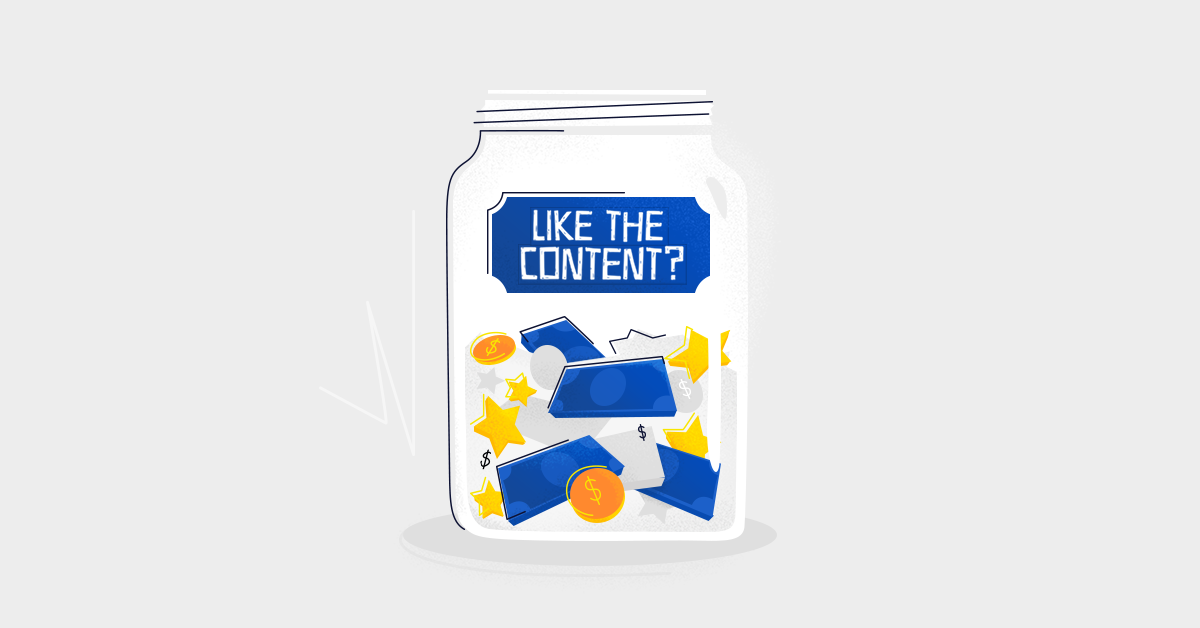Table of Contents
- New Monetization Options
- Stars as Tips for Live Streamers
- Fan Subscriptions for Recurring Revenue
- Creator Studio Overview
- What It All Means for Influencer Marketing
New Monetization Options
Facebook’s breadth of native monetization options went from zero to impressive in a short amount of time. Whether it’s Instant Articles, Instant Games, live streams, or IGTV, there’s now a cavalcade of revenue-enhanced content creation opportunities.
Facebook recently rolled out a variety of monetization options for its creators, which include paid groups, content subscriptions, less-intrusive video adroll options, and “Stars” that viewers can buy and send as tips during live streams.
These new monetization options (which were released during “Facebook Creator Day”) allow Instagram (and Facebook) to compete more directly with YouTube and Patreon as it works to build a healthy creator ecosystem. They all live within Facebook’s Creator Studio.
Facebook Wants Creators to Run their Accounts Like a Media Business
Facebook’s monetization releases make one thing clear: the social giant wants creators to treat their presences on Instagram and Facebook less like syndication for outside content and more like the primary point of publish.
When creators begin making content natively for Facebook and IGTV (instead of posting repurposed content from YouTube or Tik Tok), audiences follow. There is immense viewership value in being the social platform that "breaks" new content.
With these options, creators can grow their passion into a business, making money with any combination of monetization products that makes sense for their content and audience… we’re encouraged at the potential of this feature to help fans form deeper communities and stronger bonds with creators on Facebook.
— Sibyl Goldman, VP of Global Entertainment Partnerships @ Facebook
Stars as Tips for Live Streamers
Facebook has begun to test the expansion of a tipping feature originally built for just gaming creators. "Star" tips allow viewers to gift a certain volume of stars during live and on-demand videos as a way of providing one-time support.
Gaming influencers and other social creators earn can revenue in the form of Stars directly from fans who watch live gaming streams. Facebook is expanding this functionality beyond gamers -- a move which will allow them to compete with other live streaming apps.
Viewers can purchase packs of 100 Stars for $1.40, and streamers will get one cent per Star received during live streams. Viewers tend to send stars during key moments in live streams, be they impassioned or funny. They are meant to feel like a more impactful like.
Fan Subscriptions for Recurring Revenue
Facebook has already piloted a subscription offering for fans of a small select group of gaming streamers in certain countries. In 2020, fan subscriptions are expected to become much more widely available.
Fan subscriptions provide an attractive shift in paradigm -- a secure baseline for creators who are used to uncertainty in their streams of revenue. The wider launch of Facebook streamer subscriptions will put it in direct competition with Patreon.
We believe this feature can complement a creator’s subscription offering, and we’re testing with a small set of creators to understand how people respond.
— Sibyl Goldman, VP of Global Entertainment Partnerships @ Facebook
Facebook Will Take a Cut of Fan Subscription Revenue
Beginning January 2020, Facebook will begin to take up to a 30% share of fan subscription revenue. Billing will:
- Look at the native Android/ iOS subscription fees to determine what cut is already taken
- Subtract that amount from 30%
- Charge the difference
Creators will receive the remaining pre-tax 70%.
This is ~21% - 25% higher than Patreon’s 5% - 9% cut (before considering Patreon’s payment processing fees or native operating fees).
How Creators Will Manage Their Monetization
Facebook has built several new sections within Creator Studio, including insights dashboards and places to manage different posts on different platforms. In the Monetization Overview section, influencer talent can see all earnings from Facebook, Instagram, and IGTV. These are divvied up by platform and monetization type.
Creators will also be able to choose where to place ads on their videos in the Creator Studio. If there is a particular piece of video content that should not have ads on it, creators can turn them off (or limit their runtime to the pre-roll/ post-roll).
Our monetization offerings for creators need to be diverse, sustainable, and also provide value to people and advertisers. With this philosophy in mind, we’ve built a suite of monetization products to help creators earn money in ways they are already familiar with: through ad revenue, brand collaborations, and support from fans.
Creator Studio will also be a one-stop shop for content analytics, offering insights into how many people have seen the post, where, and what engagements have been taken.
Active Creators Will Get Access to Powerful Audience Insights
If you are a creator that invests time in the Facebook and Instagram ecosystems, Facebook Inc. will reward you with data. Creator Studio gives active creators the ability to dig deep into their audience insights. They can also to audit the health of their viewers and see the impact of their content.
Creators also now have access to more insights, including a view of their supporters’ status -- new, active, and churned -- over time.
— Sibyl Goldman, VP of Global Entertainment Partnerships @ Facebook
What Facebook and Instagram Monetization Means for Influencer Marketing
On its face, a stronger monetization backbone for creators means that they can rely less on branded content for revenue. This might feel troubling to influencer marketers -- will sponsored engagements with digital talent suffer?
One needs only to look to YouTube -- which has had native ad share, eCommerce integrations, and premium subscription revenue programs for years -- as an example of what might happen as a result of Facebook’s monetization efforts:
- The overall quality of content should improve as creators better correlate all content -- not just sponsored -- with the revenue health of their page
- Video formats on Facebook and Instagram will grow as a preferred content medium (both among marketers and algorithms)
- Creators will have a fallback revenue baseline for their content efforts. As a result, influencer talent will become more discerning with the deals they take
- This will create more scarcity in available creator options. Prices for #ad branded content flights on Instagram and Facebook might rise
Overall, marketers should not fret. Native monetization will change the fabric of creator content, but influencer marketing is not going anywhere.

